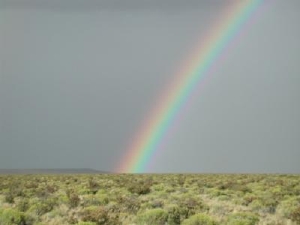Apr 24 2008
In the first experiment involving a natural environment, scientists at Brown University have shown that richer plant diversity significantly enhances an ecosystem's productivity. The finding underscores the benefits of biodiversity, such as capturing carbon dioxide, a main contributor to global warming.
 Brown University scientists Osvaldo Sala and Pedro Flombaum conducted their studies of the effect of plant species diversity on ecosystem productivity in the Patagonian steppe, a semiarid grassland located on the east side of the Andes Mountains in Argentina. (Credit: Courtesy of Osvaldo Sala, Brown University)
Brown University scientists Osvaldo Sala and Pedro Flombaum conducted their studies of the effect of plant species diversity on ecosystem productivity in the Patagonian steppe, a semiarid grassland located on the east side of the Andes Mountains in Argentina. (Credit: Courtesy of Osvaldo Sala, Brown University)
Osvaldo Sala, director of the Environmental Change Initiative and the Sloan Lindeman Professor of Biology at Brown, and Pedro Flombaum, a postdoctoral research associate in the Department of Ecology and Evolutionary Biology at Brown, said the results confirmed tests charting how biodiversity affects aboveground plant productivity in artificial ecosystems. Aboveground plant productivity (ANPP) is the amount of biomass, or organic material, produced by plant growth.
But the Brown team also learned that the correlation between plant species richness - the number of plant species in a unit of area - and ANPP in a natural ecosystem was greater than had been expected. What that means, the researchers wrote in a paper published online this week in the Proceedings of the National Academy of Sciences, is that the greater the number of plant species, the more productive the ecosystem.
Conversely, species loss has a decidedly negative impact on ecosystems. This is especially true in light of the role ecosystems play in capturing the global warming gas carbon dioxide: The fewer the plant species in a given natural environment, the less carbon dioxide they capture.
"It's a double whammy," Sala explained. "We not only are disturbing our planet by putting more carbon into the atmosphere, but we're reducing the ability of ecosystems to capture and store it."
Sala and Flombaum conducted their experiments in the Patagonian steppe, a semiarid grassland located on the east side of the Andes Mountains in Argentina. They marked 90 plots, each containing three species of native grasses and three species of native shrubs. The team then removed a certain number of species from the plots and measured each revised plot's productivity.
"The water is the same, the nitrogen is the same, the sunlight is the same," Sala said. "What is different is the diversity of the plants."
What the researchers also learned in their experiments, which ran from 2002 to this year, is that plant productivity in a flourishing ecosystem is enhanced because each species assumes a specific niche. Ecologists call this "niche complementarity." The plants use the resources available to the whole system harmoniously, such as extending their roots at different depths in the soil, using different forms of nitrogen, and staggering when they photosynthesize.
"We are deeper into understanding the mechanisms of an ecosystem's productivity," Sala said.